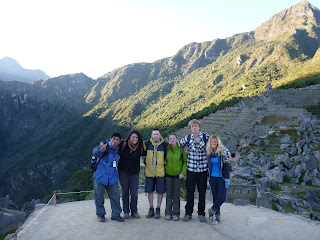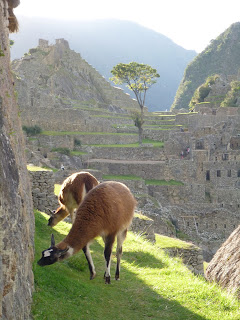This is not an event I was eager to relive - but how can I let my three-strong blog fanbase down?! You have to document the rough with the smooth; travelling isn't all a walk in the park.
6,000 metres above sea level is a height Med and I have never been to before, not even in the mountain capital of the world: Nepal. My sky dive in New Zealand was only 4,572metres (15,000ft).
What we were about to do would mean camping higher than I'd jumped out of that small plane. That should have been my first warning.
We went to the tour agency to meet our fellow trekkers, Alex and Nick from Switzerland, and to get kitted up in retro snow and ice gear that was last in fashion in the 80s - because that was when it was made. We were hoping to summit Volcan Chachani - a very serious 6075m.
Arequipa is situated in a broad valley, surrounded by three imposing volcanoes. You look anywhere towards horizon, you will see the brooding bulk of one of the volcanoes - El Misti, Chachani or Picchu Picchu. Picchu is ‘peak’ in Quechua language; Picchu Picchu means the plural: ‘peaks’.
Chachani is the highest of the volcanoes in that region at 6,075m. In the Quechua language (the first language of the Andes), Chachani means 'skirt'; and a female character is normally attributed to the mountain in local legends.
Chachani has extremely low levels of precipitation and is therefore unusual as it does not have a permanent ice cap or glaciers. This means apart from the obvious problems with altitude it is one of the few 6,000m mountains in the world that can be attempted by inexperienced climbers.
You need to be armed with an ice pick but you don't necessarily need to know how to use it.
We left for the Chachani trailhead around 8:30am and drove a long, winding 4 wheel track (that at times barely looked like a road). It’s literally a mind-numbing drive from Arequipa (2,400m) to the start of the trek (5,018m) and even our acclimatised bodies could feel the affects.
The 4WD left us, surrounded by white peaks, to hike a couple hours to the base camp - made difficult with our shoulder-pinching, back-numbing 20kg backpacks containing all our gear. Camp (5,200m) was a beautiful spot on sand where we pitched the tents and settled in for some food. There were only two other people doing the trek, so just six of us and two guides in total.
Med and I watched sunset next to a little, curly-tailed chinchilla, and then settled in to get some sleep at 5.45pm ready for our 1am wake-up call. You have to summit in the dark as any later and there is a risk of avalanches.
Despite my knack for being able to sleep anywhere, I only manage a few short stints of sleep, often found myself waking to my head thumping due to the lack of oxygen. I had had a dodgy stomach the day before and now it was coming back to haunt me. I felt so weak.
Acclimatisation and recent experience trekking at altitude clearly doesn't matter if you're not 100% fit and healthy.
Med managed to get some sleep, but I had six hours of misery and very little sleep.
At 1am we all rose into the icy air and the nausea hit me right in the guts. I tried coca leaves, altitude sickness tablets and coca tea but we had a tight time schedule and my nausea wasn't going anywhere fast.
My stubbornness subsided and I got back in the tent, into two sleeping bags this time, as well as two hats and two pairs of gloves. It's so horrible to give up on something you really want to do, especially when you then have to lie in a tent at -15 degrees for 8 hours while everyone else gets to watch sunrise up a 6,000m volcano.
For the next hour, I dry heaved into a carrier bag as I watched the whole tent turn into ice around me - making a loud scratching and cracking noise that made it impossible to sleep.
So there I lay in my igloo, alone, in the dark, at 5,200m. Eventually, after a few hours of drifting, I slept and woke just before the others returned from a really tough trek, looking dirty and exhausted.
Here's a few photographs Med took - so you don't need to miss out like I did!
6,000 metres, you'll be mine someday!
 |
| Chachani from Arequipa |
6,000 metres above sea level is a height Med and I have never been to before, not even in the mountain capital of the world: Nepal. My sky dive in New Zealand was only 4,572metres (15,000ft).
What we were about to do would mean camping higher than I'd jumped out of that small plane. That should have been my first warning.
We went to the tour agency to meet our fellow trekkers, Alex and Nick from Switzerland, and to get kitted up in retro snow and ice gear that was last in fashion in the 80s - because that was when it was made. We were hoping to summit Volcan Chachani - a very serious 6075m.
Arequipa is situated in a broad valley, surrounded by three imposing volcanoes. You look anywhere towards horizon, you will see the brooding bulk of one of the volcanoes - El Misti, Chachani or Picchu Picchu. Picchu is ‘peak’ in Quechua language; Picchu Picchu means the plural: ‘peaks’.
 |
| Spirits were high as we started our trek |
Chachani has extremely low levels of precipitation and is therefore unusual as it does not have a permanent ice cap or glaciers. This means apart from the obvious problems with altitude it is one of the few 6,000m mountains in the world that can be attempted by inexperienced climbers.
You need to be armed with an ice pick but you don't necessarily need to know how to use it.
We left for the Chachani trailhead around 8:30am and drove a long, winding 4 wheel track (that at times barely looked like a road). It’s literally a mind-numbing drive from Arequipa (2,400m) to the start of the trek (5,018m) and even our acclimatised bodies could feel the affects.
The 4WD left us, surrounded by white peaks, to hike a couple hours to the base camp - made difficult with our shoulder-pinching, back-numbing 20kg backpacks containing all our gear. Camp (5,200m) was a beautiful spot on sand where we pitched the tents and settled in for some food. There were only two other people doing the trek, so just six of us and two guides in total.
 |
| Camp: 5,200metres |
Despite my knack for being able to sleep anywhere, I only manage a few short stints of sleep, often found myself waking to my head thumping due to the lack of oxygen. I had had a dodgy stomach the day before and now it was coming back to haunt me. I felt so weak.
Acclimatisation and recent experience trekking at altitude clearly doesn't matter if you're not 100% fit and healthy.
Med managed to get some sleep, but I had six hours of misery and very little sleep.
 |
| Stunning sunset over the mountains |
My stubbornness subsided and I got back in the tent, into two sleeping bags this time, as well as two hats and two pairs of gloves. It's so horrible to give up on something you really want to do, especially when you then have to lie in a tent at -15 degrees for 8 hours while everyone else gets to watch sunrise up a 6,000m volcano.
For the next hour, I dry heaved into a carrier bag as I watched the whole tent turn into ice around me - making a loud scratching and cracking noise that made it impossible to sleep.
 |
| It got a lot more frozen than this! |
Here's a few photographs Med took - so you don't need to miss out like I did!
 |
| Summiting in the dark |
 |
| The morning shadow of El Misti volcano over Arequipa |
 |
| The summit of Chachani: 6,075metres |
Like the altitude, the sickness and headache lessened throughout the morning, and by the time we were back in Arequipa I was fine, just feeling a bit glum. We've been so lucky with our treks and expeditions in the last ten months - I'm so much more grateful for that now.
6,000 metres, you'll be mine someday!












































